Canon's 300D (Digital Rebel) vs 10D: Battle of the DSLRs
by Stephen Caston on July 5, 2004 12:23 PM EST- Posted in
- Digital Camera
The Design
|
|
|
The first considerable difference that we noticed between these two cameras is the way they felt in our hands. The Rebel casing is made of a slick, silver plastic, while the 10D casing is constructed with magnesium alloy. Because of the metal construction of the 10D, it does weigh a little more (30.5 oz with battery) than the Rebel (23 oz with battery). The 10D is bulkier in general, as you can see by its dimensions, but it feels well balanced in our hands and even has a molded, rubberized grip for the trigger hand. The extra room in its height allows for the camera's main power switch to be located on the back of the camera instead of the top. Another interesting difference was Canon's decision to put the LCD panel on the back of the Rebel, situated right above the LCD monitor. The 10D's LCD panel is on the top right, following a far more traditional Canon SLR style. The navigation system utilized by the two cameras appears to be similar except for one change - the Rebel has four arrow buttons (cross keys) and a set button in the middle, where the 10D has a wheel (Quick Control Dial) with a set button in the middle. The Main Dial, situated just behind the shutter button also serves as a means to navigate the menus.
|
|
|
|
|
|
These two cameras have virtually the same CMOS sensor, sizing in at 22.7 mm x 15.1 mm. It is important to keep in mind that the Rebel and the 10D do not have full-size sensors like the Canon 1Ds (35.8 x 23.8 mm), for example. This means a magnification factor of 1.6x. In other words, using the same lens from your 35mm film Canon EOS 300 will give you a cropped version of the same picture with the 10D and the Rebel. This can be seen as a good and bad thing. It means that to get the results you would normally get from a regular wide angle lens, you would have to buy a very expensive, super wide angle lens. However, at the same time, it means that your old 300mm telephoto lens has just earned an extra 180mm coverage, giving you a whopping 480mm effective shooting ability. Again, it all depends on how you look at the situation.
Both the 10D and the Rebel use Compact Flash (Type I or II). Also, because they have a FAT32 file system, they are able to support larger-capacity cards such as the Lexar 4GB and the Hitachi Microdrive 4GB. This is a great advantage over other types of removable media-based cameras.
|
|
|
Both cameras have a pop-up flash with a release button on the front side, opposite the shutter button. The 10D has a motorized mechanism that releases the flash, while the Rebel relies on non-motorized spring action release. We measured the Rebel's flash at 2.25 cm higher than the 10D's. This difference gives the Rebel's flash an advantage when shooting with longer lenses. Because it is higher, it has more room to shoot over the lens instead of through it (which would create shadows on the subject).
One major addition to the Rebel was the compatibility of a new type of lens, called EF-S (Electrofocus Short Back Focus). Canon introduced this lens as an 18-55mm f3.5-5.6 to be packaged with the Digital Rebel. It should be noted that EF-S lenses are not compatible with other EF mount cameras such as the 10D. The EF-S mount is marked by a white dot on the front of the camera body indicating where to align the lens when attaching it. The 18-55mm lens boasts a perfected lens coating that is supposed to minimize reflections, which would guard against flaring and ghosting. The lens is also capable of focusing at distances as close as 0.28m. Basically, Canon is trying to compensate for the 1.6x magnification factor by distributing a wide angle zoom lens with the Rebel. For the purpose of this review, I will be using a 50mm f2.5 macro lens that uses an EF mount simply because it will fit on both cameras.
The controls for adjusting picture settings are a little different for each camera (mostly because of the subtraction of the wheel on the Rebel). The Main Dial is responsible on both cameras for adjusting the:
- Aperture in Av (Aperture Priority) mode
- Shutter speed in (Shutter Priority)Tv mode
- Shutter speed and aperture combination in P (Program AE) mode
- Shutter speed in Manual mode
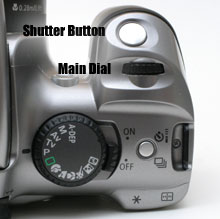
On the 10D, adjusting the aperture in Manual mode is just a simple turn of the Quick Control Dial. On the Rebel, you have to hold down the Av/Ec (Aperture value/Exposure compensation) button while you turn the Main Dial in order to adjust the aperture. While the button is within reach of my thumb, it is certainly more convenient on the 10D to spin the wheel.
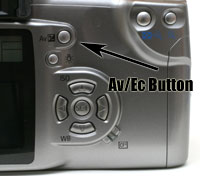
One huge advantage that the 10D has over the Rebel is the option to adjust Custom Functions under the main menu. One such option is to enable mirror lockup. Mirror lockup is when the mirror flips up prior to exposure in order to help prevent vibrations normally caused by the mirror movement. Any wildlife photographer would need to utilize this feature to keep their images sharp while shooting with telephoto lenses. The same applies to macro photographers. Mirror lockup ability is not a feature of the Rebel. In addition to mirror lockup, you are given the option to separate AF (Auto Focus) from AE (Auto Exposure) lock (normally, they coincide), which is very helpful in circumstances where you want to have total control over the exposure lock (function 4). Another option allows you to control the activity of the AF-assist beam. In automatic modes, if the ambient light is too low, the flash will emit short preliminary flashes in order to attain focus. Sometimes, this can be frustrating if you are in situations where the extra flashing could impose on your subject. Luckily, custom function 5 gives you control of the nature of the assist beam. Another really cool feature is the option to enable auto reduction of the fill flash. Basically, this option is for situations when you are shooting outdoors with ambient light and you want to use the flash as a fill light to cancel out unneeded shadows. Enabling this option (function 14) will automatically weaken the flash if the ambient light levels are bright enough. This is to ensure a well exposed background while preventing the flash from washing out your subject. These are just a few of the 17 custom functions on the 10D.
Two more features that the 10D offers are the ability to select what type of metering and auto focus that you would like. For metering, you can choose between evaluative 35-area, partial (9% of viewfinder), and center-weighted average. The Rebel has the ability to do these metering modes too, but it automatically decides what is best and offers no input from the user. On the 10D, the user can choose between One Shot AF (for still subjects), AI Servo AF (to track moving subjects), or AI Focus AF (to let the camera switch from One Shot to Servo if it detects movement). Again, the Rebel has these features, but gives the user no control over them.
The 10D is capable of taking 9 consecutive frames at 3 fps, while the Rebel can take 4 consecutive frames at 2.5 fps. This advantage of the 10D may be more important to some photographers if they are likely to be shooting sports events or other fast-paced subjects.


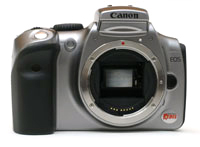

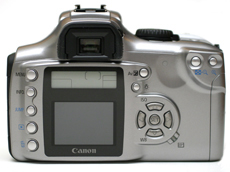
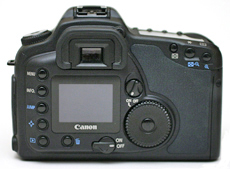
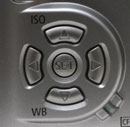
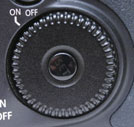
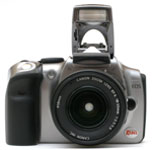
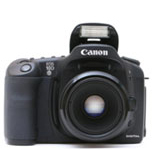








19 Comments
View All Comments
hixen - Thursday, September 23, 2004 - link
everyone looking for the "hack"http://satinfo.narod.ru/en/index.html
rapope - Thursday, September 9, 2004 - link
Hi,I don't agree. Why wouldn't someone start with a 10D? For example, let's say that someone has a sizable investment in Canon EF L lenses and wants to make the jump to digital? The 10D/20D would be a good choice for those who own a bunch of lenses and who don't want to break the bank on a digital SLR.
I'm currently considering making such a move. The EOS 20D would be a fine addition to my EOS-1 and EOS-3. I could decide to get a digital made around the EOS-1 at a later time.
Whaddaya think??
RP
rapope - Thursday, September 9, 2004 - link
Nice review, very detailed, with lots of useful information. Will you be posting an update based on the newly-released 20D?Thanks!!
511PF - Friday, July 9, 2004 - link
I think you did an excellent job in your review. I especially enjoyed the side by side noise and color comparisons. I thought the topic was very relevant and direct comparisons between the 300D and 10D are not that common. I thought the hands-on battery review was excellent as well. Every review adds something new and different. Yours was no exception.I find it unfortunate that some of the people here have a need to tear other people's work down. I appreciate your work and I think you did a good job. Thanks!
Mday - Friday, July 9, 2004 - link
yeah, i totally agree. First, there's no way anyone would START with the 10D. the 300D, maybe, but the person needs to be seriously wanting to get into photography. Otherwise, if all you want is a simple camera, there's no need to go with the "DSLRs". For MOST PPL, a fixed lens solution works just fine. Personally, i have outgrown a fixed lens solution, but i dont have the $$$ to get a real camera simply because the cost of lenses are $$$$$ compared to the cost of the camera.Besides, no one cares about any battles between the 10D and 300D. The battles are between the other $1000 DSLRs. So far, Nikon is winning imo.
WooDaddy - Thursday, July 8, 2004 - link
I'd have to agree with the majority of comments here. I'm sure stephen meant well by the review but I don't feel that Anandtech is an appropiate forum to discuss digital cameras. Dpreview is hands-down the best place for camera reviews.. Mind you, it is so because of the more photographic related points made during the review. Additionally, they focus on photogs not gadget lovers. A gadget lover wouldn't even consider a 10D, though a Rebel would be in their alley. (Personally, I have a Nikon FE2 with a Acer ScanWit 2420 and Minolta G400).I have a feeling the MAIN reason why this whole review was posted and even considered was what was noted in the last paragraph... a hack. Hacks/overclocking/deals/best bang for you buck all are issues that Anandtech readers love, hence the weekly buyers guides, overclocking tests, etc. This would have been best located as a post in the forums somewhere. Once I read that single paragraph, the jig was up and I was even more disappointed.
Additional 2c:
Anyone getting started in photography shouldn't use a 10D quality camera. Grasshopper, you must first realize it is the photographer, not the camera that takes great pictures. AF, AE, etc. should be regarded as luxuries not as requirements. Once you learn how to use a manual camera (Zone method, etc), one can appreciate automatic features. Same idea with digital cameras. Start small (S410 or S50) then move up to the big boys.
... phew... </rant>
stephencaston - Wednesday, July 7, 2004 - link
kaltree,The resolution test was done in RAW mode for both cameras and then converted to JPG in PS CS with +1.0 EV applied.
The rest of the image quality tests (including white balance) were done with both cameras reset to factory default settings and using the lowest compression JPG mode (Large/Fine 3072x2048). This allowed us to compare how both cameras process images using their default settings.
kaltree - Wednesday, July 7, 2004 - link
Does anyone know if the image quality and white balance tests were shot in RAW or JPEG mode?Reason is the tests will be uneven. The 300D will sharpen the image slightly more causing a degradation in resolution. Also, the 300D does boost the saturation slightly. The shots need to be done in RAW only and those images need to be compared. If I missed the fine print, I apologize.
(Canon 300D owner since August 2003)
broken33 - Wednesday, July 7, 2004 - link
Dpreview does indeed offer a far more comprehensive and frankly, believable review of each of these cameras.
I agree that you should instead focus on the computer-related issues that are involved with these kinds of cameras. It would be *GREAT* if you would post a comprehensive review of the firmware hacks for the 300D that are out there or do an overview of the various storage options that are out now. Hell, you could do a comprehensive look at performance issues with new CF cards - which ones are really worth the money and with what cameras are they best suited.
JetJock - Wednesday, July 7, 2004 - link
The D-Rebel cannot compare to Nikon's D70. Check it out. It is just slightly more expensive than the D-Rebel ($100 or so) and has many more features and better design / build.